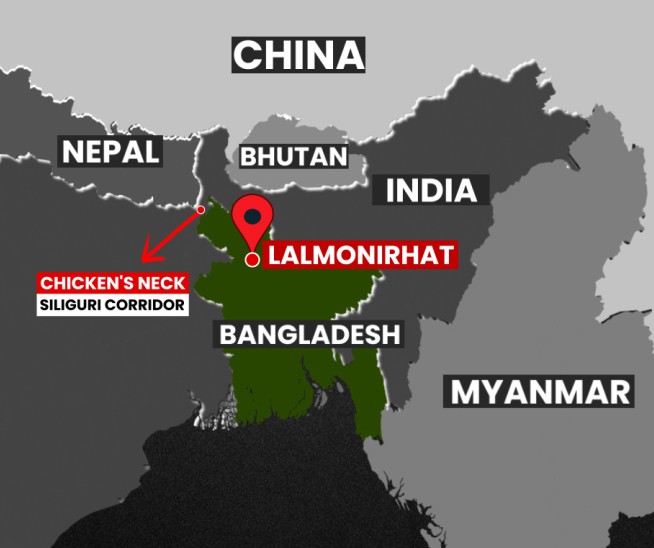China’s reported involvement in reviving the long-abandoned Lalmonirhat airbase in northern Bangladesh, just 135 kilometres from India’s critical Siliguri Corridor, has triggered fresh strategic concerns in New Delhi. Located barely 12-15 kilometres from the Indian border, the airbase lies perilously close to the 22-kilometre-wide ‘Chicken’s Neck’—India’s vital land link to its northeastern states.
Originally built in 1931 by the British and used during World War II by Allied forces, Lalmonirhat had fallen into disuse until the recent push by Bangladesh’s interim government under Mohammed Yunus to reactivate six vintage airstrips for economic purposes. However, a recent visit by Chinese officials to the site, combined with ongoing Chinese investment in surrounding regions, has raised fears that the airbase could serve dual civilian-military purposes.
The airbase’s revival comes against the backdrop of China’s broader expansion of military infrastructure along the Himalayan frontier. Since 2024, Beijing has upgraded multiple airbases near the Line of Actual Control (LAC), enhancing their operational readiness with improved aprons, support facilities, and drone capabilities. Indian defence experts warn that China’s concept of “airbase clusters” allows quick deployment, greater survivability, and sustained aerial presence near sensitive border areas.
According to Sriparna Pathak, a China Studies professor at OP Jindal Global University, any potential Chinese military involvement at Lalmonirhat could allow monitoring of Indian troop movements through the Siliguri Corridor. This corridor, vital to India’s territorial integrity, has been under increased scrutiny since the 2017 Doklam standoff exposed its vulnerability to hostile manoeuvres from the China-Bhutan-India tri-junction.
China’s expanding presence in Bangladesh is not limited to aviation. Beijing-backed companies are operating solar plants and industrial projects near Rangpur and planning a satellite city, often with minimal local participation. A Dhaka-based journalist noted that most of these enterprises are run entirely by Chinese personnel, raising questions about economic sovereignty and external influence in Bangladesh.
Strategic experts believe the timing is significant. Kalpit Mankikar, a China-Taiwan Studies fellow at the Observer Research Foundation, notes that under the deposed Sheikh Hasina government, Bangladesh maintained a balance in regional relations. However, the new interim leadership appears more receptive to Chinese overtures, potentially altering the region’s geopolitical balance. Mankikar warns that such developments could serve as a springboard for increased surveillance or influence against India.
Adding to India’s worries, a Pakistani military-intelligence delegation reportedly visited parts of northern Bangladesh ahead of the Chinese visit. With Pakistan’s long history of supporting insurgent groups in India’s northeast via Bangladeshi territory prior to 2009, this rekindled trilateral dynamic raises red flags in Indian security circles.
Indian Army Chief General Upendra Dwivedi has expressed concern over the possibility of hostile elements using neighbouring territory to target India, especially given Pakistan’s legacy as an “epicentre of terrorism.” His remarks reflect broader apprehension about the potential misuse of revived infrastructure for cross-border subversion.
In response, India has been upgrading key airbases such as Ambala and Hasimara, bolstering radar networks and cyber-defence systems. But experts acknowledge a growing technological gap. China’s deployment of approximately 195 J-20 stealth fighters, along with the recent unveiling of AI-powered stealth platforms dubbed J-36 and J-50, gives the PLA Air Force a qualitative edge over India’s currently non-stealth fleet.
Geospatial researcher Damien Symon notes that China’s military posture reflects not just contingency planning, but an ambition for permanent forward deployments. The revival of the Lalmonirhat airbase, whether civilian or not, fits into this larger pattern of creating a dense network of dual-use infrastructure across South Asia.
As India monitors developments along its vulnerable northeast corridor, the proximity of Chinese-backed infrastructure in Bangladesh presents not just a tactical threat, but a test of New Delhi’s ability to manage complex regional equations involving both immediate neighbours and great powers.













